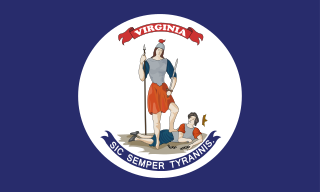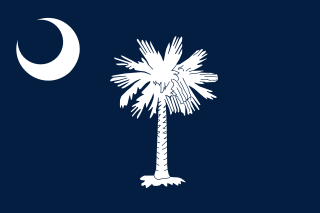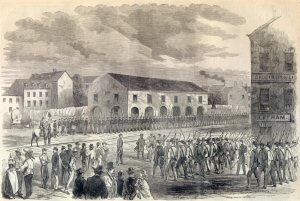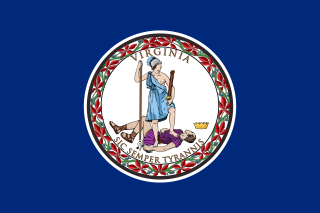Related Research Articles
The Stonewall Brigade of the Confederate Army during the American Civil War, was a famous combat unit in United States military history. It was trained and first led by General Thomas J. "Stonewall" Jackson, a professor from Virginia Military Institute (VMI). His severe training program and ascetic standards of military discipline turned enthusiastic but raw recruits into an effective military organization, which distinguished itself from the First Battle of Bull Run in 1861 to Spotsylvania Court House in 1864. Its legacy lives on in the 116th Infantry Brigade, which bears the unofficial nickname "Stonewall Brigade," and in several living history reenactment groups.
The 201st Field Artillery Regiment is a West Virginia Army National Guard regiment. It currently perpetuates the Virginia elements of the Maryland and Virginia Rifle Regiment, which fought in the American Revolution. Organized by Colonel Morgan Morgan in Bunker Hill, West Virginia in 1735, it is one of the oldest continually-active regiments in the U.S. Army, and the oldest unit in the West Virginia Army National Guard. Units also saw action on both sides of the American Civil War, with many companies of the regiment combined to form the Union Army's 1st West Virginia Infantry.

The Army of the Shenandoah was a field army of the Confederate States Army active during the American Civil War. It was created to defend the Shenandoah Valley of Virginia from Union Army attacks during the early months of the war. The army was transferred to reinforce the Confederate Army of the Potomac at the First Battle of Bull Run, which was the only major engagement of the war it participated in. After the battle, the army was merged into the Army of the Potomac.

The 33rd Virginia Infantry Regiment was an infantry regiment raised in the Commonwealth of Virginia for service in the Confederate States Army during the American Civil War. It was a part of the famed "Stonewall Brigade," named for General Stonewall Jackson.

Hampton's Legion was an American Civil War military unit of the Confederate States of America, organized and partially financed by wealthy South Carolina planter Wade Hampton III. Initially composed of infantry, cavalry, and artillery battalions, elements of Hampton's Legion participated in virtually every major campaign in the Eastern Theater, from the first to the last battle.

The city of Winchester, Virginia, and the surrounding area, were the site of numerous battles during the American Civil War, as contending armies strove to control the lower Shenandoah Valley. Winchester changed hands more often than any other Confederate city.

The Danville Artillery was a field artillery company in the Confederate States Army, Army of Northern Virginia during the American Civil War. It was also referred to informally as a battery, although this reference was only infrequently used during the war.
A. P. Hill's Light Division was an infantry division in General Robert E. Lee's Confederate Army of Northern Virginia during the American Civil War. Originally including six brigades, the division's first commander starting May 27, 1862 was then Major General A. P. Hill. Major Generals William Dorsey Pender and Cadmus M. Wilcox commanded a reorganized Light Division in the Army of Northern Virginia after Hill's promotion to corps command and Pender's death at the Battle of Gettysburg, respectively.

William Thomas Poague was a Confederate States Army officer serving in the artillery during the American Civil War. He later served as Treasurer of the Virginia Military Institute.
Fort Carpenter, Alleghany County, Virginia, was built about 1755-1756 by Joseph Carpenter, who migrated from the Province of New York to "the big bend" of the Jackson River on the Virginia frontier about 1745-1746. It was actually a fortified house, or blockhouse. Located on a low bluff near the mouth of Carpenter Creek, it was later known as Cedar Hill. Logs and stones from the original structure were used in the later dwelling now on the site. A young George Washington visited the string of frontier forts during the French and Indian War in 1756, inspecting Fort Young on the north side of the Jackson River, and Fort Carpenter, described as a fortified house, on the south side. In 1856, Joseph Hannah Carpenter graduated from the Virginia Military Institute as a civil engineer, and later went on to serve as an artillery cadet under the command of Stonewall Jackson.

The 27th Virginia Infantry Regiment was an infantry regiment raised in Virginia for service in the Confederate States Army during the American Civil War. It fought mostly with the Stonewall Brigade of the Army of Northern Virginia.

The 2nd Virginia Infantry Regiment was an infantry regiment raised in today's western Virginia and what became West Virginia during the American Civil War for service in the Confederate States Army. It would combine with the 4th, 5th, 27th, and 33rd Virginia infantry regiments and the Rockbridge Artillery Battery and fight as part of what became known as the Stonewall Brigade, mostly with the Army of Northern Virginia.

The 4th Virginia Volunteer Infantry Regiment was an infantry regiment raised in southwestern Virginia for service in the Confederate States Army during the American Civil War. It fought in the Stonewall Brigade, mostly with the Army of Northern Virginia. Though it suffered heavy losses, two surviving officers resumed political careers after the conflict and won election to the U.S. House of Representatives, and several more served in the Virginia General Assembly.

The 18th Virginia Infantry Regiment was an infantry regiment raised in Virginia for service in the Confederate States Army during the American Civil War. It fought mostly with the Army of Northern Virginia.

The 19th Virginia Infantry Regiment was an infantry regiment raised in Virginia for service in the Confederate States Army during the American Civil War. It fought mostly with the Army of Northern Virginia.
The Pee Dee Light Artillery was a distinguished Confederate light artillery battery during the American Civil War. The origins of the battery began as the Darlington Guards, a local militia of Darlington, South Carolina. The Darlington Guards volunteered their service to South Carolina on January 4, 1861, for a period of six months. These men were the very first soldiers to volunteer to fight in Civil War. They became Company B, First South Carolina Volunteers, commanded by Captain F.F. Warley and Lieutenant David Gregg McIntosh. After six months on the Charleston, South Carolina, coast and a short campaign in Virginia, the unit was released. Half the unit remained with Captain Warley and served the remainder of the war as the Darlington Guards. The other half reformed in Darlington, South Carolina, under McIntosh. The unit called themselves the Pee Dee Rifles and in August 1861 rendered their service as an infantry unit to the Confederate States of America for the duration of the war. While in training in Suffolk, Virginia, in the winter of 1861-62, the unit was reorganized as Company D, First South Carolina Regiment, a light artillery battery, and became the Pee Dee Light Artillery.
Battery A, 1st New Jersey Light Artillery was an artillery battery that served in the Union Army during the American Civil War.
Battery I, 1st Regiment of United States Artillery was a field artillery battery of the United States Army between 1821 and 1901 that notably served in the Union Army during the American Civil War.
Independent Battery D, Pennsylvania Light Artillery, was an artillery battery that served in the Union Army during the American Civil War. The unit organized on 21 September 1861 and served until 13 June 1865. The battery participated in the battles of Second Bull Run, Chantilly, South Mountain, Antietam, and Fredericksburg in 1862. The following year, Battery D transferred to the Western theater where it took part in the Siege of Vicksburg and other operations. The years 1864–65 saw the unit fight at the first Petersburg assault, the Crater, Ream's Station, Battle of Peebles's Farm, Fort Stedman, and the final Petersburg assault. Battery D took part in the Grand Review of the Armies before being mustered out.

The Donaldsonville Louisiana Artillery was a Louisiana artillery unit that fought in the Confederate States Army during the American Civil War. Formed from an old militia company, it arrived in the Eastern Theater of the American Civil War in September 1861 with three obsolete guns and was equipped with three additional rifled guns. The battery fought at Yorktown, Williamsburg, Seven Pines, Gaines' Mill, Glendale, Second Bull Run, Antietam, Shepherdstown and Fredericksburg in 1862. The following year the unit served at Gettysburg and in the Bristoe and Mine Run campaigns. The battery fought in the Overland campaign and at the Siege of Petersburg in 1864. It surrendered at Appomattox in April 1865.
References
- ↑ Clarence Albert Fonerden. 1911. A Brief History of the Military Career of Carpenter's Battery from its Organization as a Rifle Company under the Name of the Alleghany Roughs to the Ending of the War Between the States. New Market, Va.: Henkel & Co., Printers, 78 pp.
- ↑ Joseph H. Carpenter papers. (MS #333), Virginia Military Institute Archives, online guide accessible at http://www.vmi.edu/archives.aspx?id=3945; and Fonerden, p. 68.
- ↑ Fonerden, p. 15.
- ↑ Fonerden, p. 68; and Mary Evelyn Harlow Carpenter: The Carpenters of Fort Carpenter, 1746-1949, privately published, Covington, Va., ca. 1949, 67 pp. + pls.
- ↑ Fonerden, p. 15.
- ↑ U.S. National Park Service: 27th Virginia Infantry, Record After First Manassas, http://www.nps.gov/mana/forteachers/upload/27thVaRecAfterAvery5389.pdf.
- ↑ Carpenter: The Carpenters of Fort Carpenter, 1746-1949.